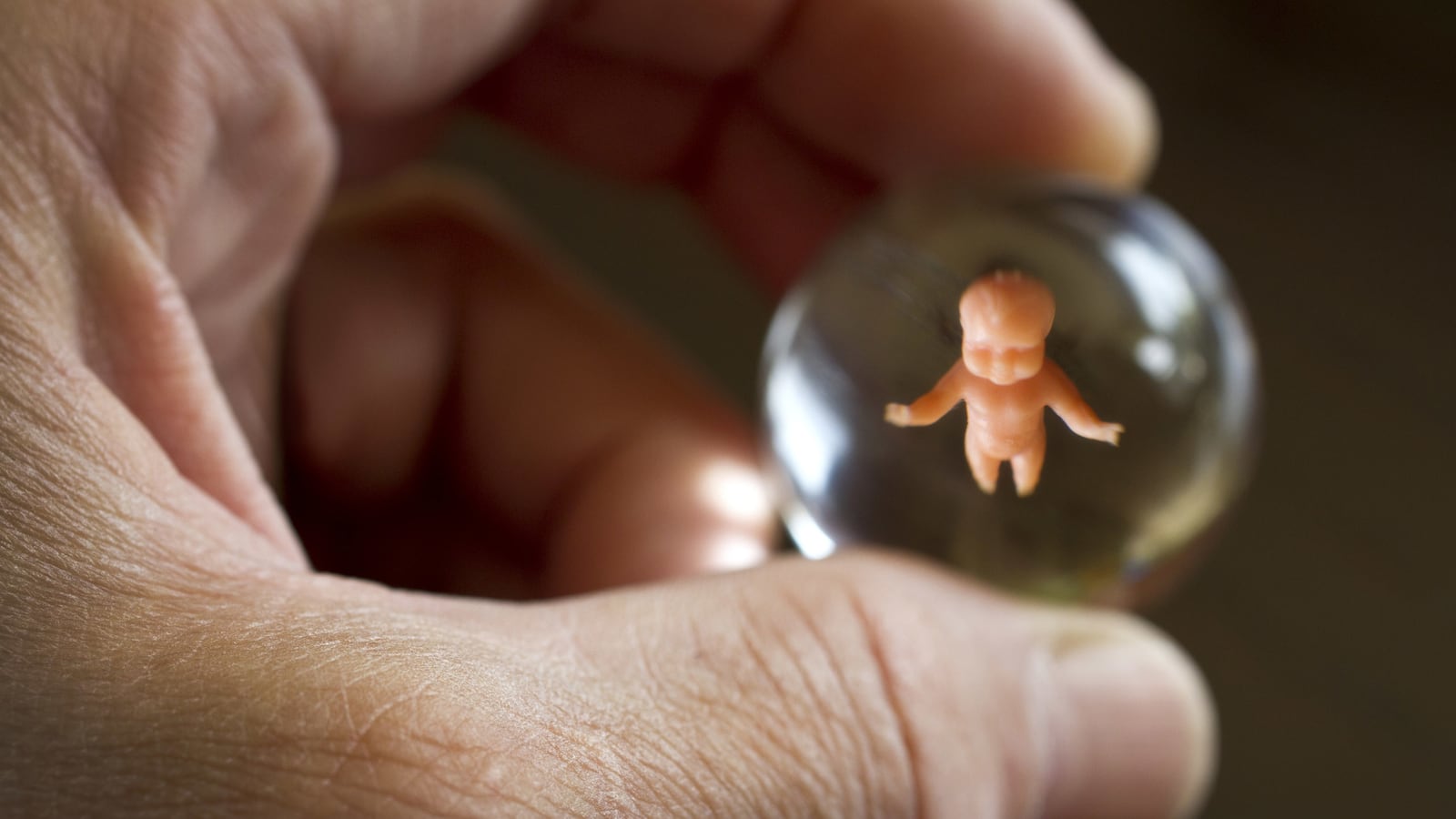The idea that a human fetus can be raised outside of a woman’s body is so radical that our language can barely describe it.
The term “gestation,” for instance, is derived from the Latin verb gestāre, used to describe a mammal carrying a burden. And the Latin mātrīx for “womb” comes from the same Indo-European root that gives us the English “mother.” How, then, can gestation happen if no one is carrying the fetus? And how can a womb exist outside of a mother? Given these linguistic impossibilities, British scientist J.B.S. Haldane had to coin the term ectogenesis—literally “developing outside”—in 1924 to describe a scientific advance that was then nothing but a science-fiction fantasy: the artificial womb.
But ectogenesis may pass from the pages of Brave New World into reality within 30 years, according to a new Motherboard report by transhumanist futurist Zoltan Istvan.
The technology behind ectogenesis, as feminist journalist Soraya Chemaly notes, has been in development for at least a decade. In 2003, a team of Cornell scientists began growing mouse embryos in artificial wombs but could only grow human embryos for 10 days due to current legislation, which places a two-week restriction on this line of research. Istvan believes that these legal obstacles can be circumvented, and that the artificial womb will be here by the end of the 21st century, along with a host of legal and cultural consequences.
What will ectogenesis mean for feminism in particular as it navigates this staggeringly complex intersection of medicine, bioethics, and reproductive politics? Istvan frames the debate surrounding ectogenesis as a fight between feminists who don’t want to “hand over women’s sacred birthing ability to science” and scientists who believe it can help mothers avoid the medical dangers of childbirth. Newsweek, too, pits a particular brand of second-wave feminism that sees reproduction as the exclusive and necessary province of women against the scientists developing artificial womb technology.
But the implications of ectogenesis for feminism far exceed a conflict between scientific researchers and a small but established group of old-guard feminists. In a culture that is founded on the symbolic link between womanhood and reproduction, and in a political climate where so many feminist political efforts of the past have been predicated on that link out of sheer necessity, the separation of gestation from a woman’s body will have earth-shattering consequences for the contemporary feminist movement. The artificial womb, after all, is a 21st-century technology and with it will come with 21st-century consequences.
Ectogenesis will pry open every gendered fault-line in contemporary cultural politics, from workplace politics to the men’s rights movement to an increasingly virulent abortion debate. The artificial womb will undoubtedly improve the lives of some women who opt to use it, but the separation of childbirth from a woman’s body will also give the anti-feminist Right terrifying new points of leverage at a crucial moment in feminist history.
The feminist rationale for ectogenesis seems to practically write itself. In theory, it could allow prospective mothers to completely circumvent the medical dangers of pregnancy and childbirth. While maternal death is relatively rare in the developed nations that would likely have access to ectogenesis initially, the maternal mortality rate is actually on the rise in the United States, with 18.5 maternal deaths per 100,000 live births, as opposed to 12.4 maternal deaths per 100,000 births in 1990. But the manifold complications of pregnancy are likely motivation enough for many prospective mothers to choose an artificial womb over the one inside their own bodies.
In professional climates, too, where women feel social pressure to hide their pregnancies, ectogenesis would allow women to have babies on their own timetable, away from the prying eyes of supervisors and co-workers. As new data from the U.S. Equal Employment Opportunity Commission shows, pregnancy discrimination continues to affect women in every field in every locality in the country. If ectogenesis becomes an affordable option for working women, pregnancy discrimination could be avoided altogether by rendering gestation and childbirth completely invisible to employers and prospective employers alike.
But while many women would gladly sidestep the physical and professional consequences of pregnancy and childbirth, the anti-feminist Right is also poised and ready to celebrate the additional distance that ectogenesis would place between a woman and her child.
Men’s Rights Activists (MRAs), for example, are already claiming the artificial womb as karmic payback for the recent discussion surrounding the diminishing role of men and masculinity in a post-industrial world, a discussion that reached its high-water mark around “The End of Men,” Hannah Rosin’s widely-read column in The Atlantic and her 2012 book of the same name. Starting from evidence that parents in the United States who use new sperm selection techniques are starting to express a stronger preference for girls, Rosin considered what it would mean to live in a world where women dominate the workforce, the academy, and the home.
When last week’s Newsweek report on the artificial womb found its way to the Men’s Rights subreddit, an Internet message board that has been marked by the Southern Poverty Law Center as a “woman-hating site” since 2012, members of the subreddit reacted as if they had just pulled off a stunning wrestling reversal while down for the count. “Maybe the article should have been titled ‘The End of Women,’” one commenter wryly observed. Another commenter ventriloquized feminist concerns with ectogenesis in this way: “We can kill all men and keep the species going based off of sperm banks! Wait, you don’t need us for reproduction anymore? That’s misogyny!” The tone, across the board, was nothing short of jubilant. Finally, it seemed, the artificial womb would literalize their claims of equal importance in human reproduction by making a woman’s body unnecessary for gestation.
MRAs have long resented women for receiving paid maternity leave, for being favored in child custody decisions, and for insisting that women’s bodies remain at the center of reproductive politics. On the subreddit, the artificial womb is already being hailed as the solution to these perceived inequalities. Some MRAs are preemptively celebrating a future in which women do not have access to the supposed “social power” that women have by virtue of childbirth. And another thread of comments shows MRAs imagining a future in which women who want to receive an abortion are required to transplant their fetus into an artificial womb to be raised by the father or a “charitable organization” upon birth. Soraya Chemaly already predicted this particularly “surreal” argument in her initial report on ectogenesis.
But conservative politicians who take up this same line of anti-abortion argumentation would be forced to choose between celebrating the artificial womb as a medical innovation that can preserve the lives of endangered fetuses, and denouncing the artificial womb on religious and moral grounds. The 2012 Republican Platform still states definitively: “We oppose federal funding of embryonic stem cell research.” And some religious commentators who have caught wind of ectogenesis certainly don’t seem to hold it in very high esteem. In America: The National Catholic Review, for example, John Nassivera solemnly intones that ectogenesis is “a very serious thing.”
These portentous rumblings aside, no coherent position on ectogenesis has emerged so far within the pro-life movement. National Right to Life issued a single fact sheet on ectogenesis in 2005 that expresses alarm at the prospect of a functional artificial womb, but primarily seems to take exception to the fact that the development of the artificial womb will require human embryos to be developed to “later stages of development before killing them.” In 2003, Albert Mohler, president of the Southern Baptist Theological Seminary, wrote in a more optimistic register that “ectogenesis is a significant threat to the culture of death and the logic of Roe,” but the Southern Baptist Convention has yet to articulate any formal position on the artificial womb.
But if Zoltan Istvan is correct, ectogenesis is inevitable, and pro-life political groups will be forced to take a stand. By removing gestation from the bodies of women, the artificial womb will put the rhetoric of pro-life politicians to the ultimate test: is their stated concern for the “life of the child” earnest, or is it nothing but a pretext for gaining control over women’s bodies? If ectogenesis becomes a cultural reality in spite of religious and moral objections, will Republicans insist that artificial wombs be used to save the lives of soon-to-be-aborted fetuses or will they continue to condemn both ectogenesis and abortion in equal measure? Simply put, if you remove women’s bodies from the equation of childbirth, will that take all of the perverse, misogynistic fun out of pro-life political efforts?
Feminists face new enemies in the 21st century: a vocal group of male activists embittered by the political successes of feminism over the past few decades and a religious Right that is desperate to regain a foothold in the abortion debate after 40 years of Roe v. Wade. Ectogenesis will change women’s relationship to childbirth forever, potentially allowing them to avoid the physically and professionally deleterious consequences of pregnancy.
But feminism’s new enemies are also waiting in the wings, carefully eyeing the political strategies that ectogenesis will open up for them. The womb may become artificial by the end of the century but it will still be the battleground for feminist politics.






